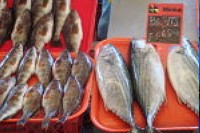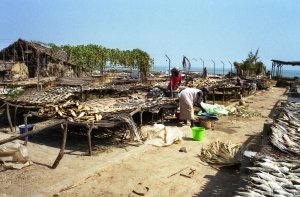 World per capita fish supply reached a new record high of 20 kg in 2014. About half of this was due to aquaculture according to estimates published by the Food and Agriculture Organization of the UN (FAO) in its report on the State of world fisheries and aquaculture 2016.
World per capita fish supply reached a new record high of 20 kg in 2014. About half of this was due to aquaculture according to estimates published by the Food and Agriculture Organization of the UN (FAO) in its report on the State of world fisheries and aquaculture 2016.
Although annual per capita consumption of fish has grown steadily in developing regions (from 5.2 kg in 1961 to 18.8 kg in 2013) and in low income food-deficit countries (LIFDCs) (from 3.5 to 7.6 kg), it is still considerably lower than that in more developed regions, even though the gap is narrowing. The may be under-estimates, because artisanal and subsistence fisheries are very poorly covered in national statistical systems and thus also by FAO.
- An estimated 93 million tons of fish and other aquatic organisms were caught world-wide in 2014 according to FAO.
- An estimated 81.5 million tons were from marine waters, about 11.9 million tons from freshwaters. But there are almost as many freshwater fish species than there are in the oceans (see www.fishbase.org).
- An estimated 73.8 million tons of fish and other aquatic organisms (but not counting marine plants) were produced through some form of farming or husbandry in 2014 (up from 51.7 million in 2006). 47.1 million tons were from freshwaters, 26.7 million tons from marine waters. China accounts for approximately 60% of global aquaculture production.
- Importantly in terms of food security and the environment, about half of the world’s aquaculture production of animals and plants came from non-fed species. These species include silver and bighead carps, filter-feeding animal species (e.g. bivalve molluscs) - and seaweeds. But increases were stronger in fed species than in non-fed ones.
- Aquatic plant farming, overwhelmingly of seaweeds, has been growing rapidly and is now practised in about 50 countries.
- An estimated 146.3 million tons out of total production of 167.2 million tons were for human consumption (compared to 110.4 million tons out of 143.6 million tons estimated for 2006). About 20.9 million tons were for non-human use, mostly for fish meal and oil (much of this for aquaculture feeds).
- Between 11 and 26 million tons of fish were caught illegally and/or are unreported and/or the result of unregulated (IUU) fishing (Agnew et al., 2009). The damage created by these illicit activities were between US$ 10 and 23.5 billion annually. For more information, click here.
- A recent study finds that reconstructed global catches between 1950 and 2010 were 50% higher than data reported by governments to FAO suggest, and are declining more strongly since catches peaked in the 1990s (Pauly and Zeller, 2016).

- Production of aquatic animals from aquaculture in 2014 amounted to 73.8 million tonnes, with an estimated first-sale value of US$160.2 billion.
- In 2014 and 2015, the European Union (EU) was by far the largest single market for fish imports, followed by the United States of America and Japan.
- In 2014, fishery exports from developing countries were valued at US$80 billion, and their fishery netexport revenues (exports minus imports) reached US$42 billion, higher than other major agricultural commodities (such as meat, tobacco, rice and sugar) combined.
- An estimated 56.6 million people were engaged in the primary sector of capture fisheries and aquaculture in 2014, of whom 36 percent were
engaged full time, 23 percent part time, and the remainder were either occasional fishers or of unspecified status. Numbers remained relatively stable since 2010. - In 2014, 84 percent of the global population engaged in the fisheries and aquaculture sector was in Asia, followed by Africa (10 percent), and Latin America and the Caribbean (4 percent). Of the 18 million people engaged in fish farming, 94 percent were in Asia.
- Women accounted for 19 percent of all people directly engaged in the primary sector in 2014, but when the secondary sector (e.g. processing,
trading) is included women make up about half of the workforce. -
 Perhaps as many as four times more people work in activities associated with fishing and aquaculture (boat building and repair, making and repair of gear, feeding and tending in aquaculture, post-harvest handling of fish, marketing). Women play an important role in both the catching and culture sectors, mostly as entrepreneurs and labourers in pre- and post-harvest activities. Assuming that three other dependent family members take advantage of the sector, this adds up to more than half a billion people, close to 8% of the world population. (Foto courtesy Cornelia E. Nauen)
Perhaps as many as four times more people work in activities associated with fishing and aquaculture (boat building and repair, making and repair of gear, feeding and tending in aquaculture, post-harvest handling of fish, marketing). Women play an important role in both the catching and culture sectors, mostly as entrepreneurs and labourers in pre- and post-harvest activities. Assuming that three other dependent family members take advantage of the sector, this adds up to more than half a billion people, close to 8% of the world population. (Foto courtesy Cornelia E. Nauen)
NB: Unless indicated otherwise, all data from the 2016 State of Fisheries and Aquaculture report of FAO. Note, however, that catch reconstructions of independent scientists from around the world in a huge effort orchestrated by the Sea Around Us project, headed by Prof. Daniel Pauly at the University of British Columbia, Canada, point to the urgent need to revise the statistics that are provided by governments and used by the FAO in this compilation. Click here for a constructive criticism of SOFIA 2016. To access the data independently developed the Sea Around Us project, click here.








